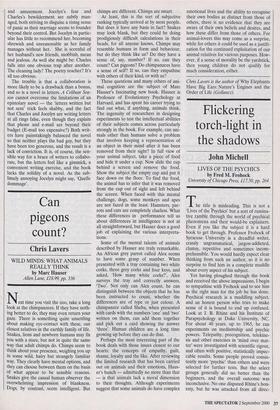Can pigeons count?
Chris Lavers
WILD MINDS: WHAT ANIMALS REALLY THINK by Marc Hauser Allen Lane, £18.99, pp. 336 Next time you visit the zoo, take a long look at the chimpanzees. If they have noth- ing better to do, they may even return your gaze. There is something quite unsettling about making eye-contact with these, our closest relatives in the earthly family of life. Snakes, lions and newborn humans may fix you with a stare, but not in quite the same way that adult chimps do. Chimps seem to think about your presence, weighing you up in some wild, hairy but strangely familiar way. They clearly have mental options, and they can choose between them on the basis of what appear to be sensible reasons. Snakes give the casual human observer the overwhelming impression of blankness. Dogs, by contrast, seem intelligent. But chimps are different. Chimps are smart.
At least, this is the sort of subjective ranking typically arrived at by most people. But does it have any basis in fact? Snakes may look blank, but they could be doing prodigiously difficult calculations in their heads, for all anyone knows. Chimps may resemble humans in form and behaviour, but do they think like us? Do they have a sense of, say, number? If so, can they count? Can pigeons? Do chimpanzees have a sense of self? If so, can they empathise with others of their kind, or with us?
These questions and many others of ani- mal cognition are the subject of Marc Hauser's fascinating new book. Hauser is Professor of Evolutionary Psychology at Harvard, and has spent his career trying to find out what, if anything, animals think. The ingenuity of researchers in designing experiments to test the intellectual abilities of their subjects comes across particularly strongly in the book. For example, can ani- mals other than humans solve a problem that involves keeping a representation of an object in their mind after it has been removed from their sight? In full view of your animal subject, take a piece of food and hide it under a cup. Now slide the cup behind a screen and remove the food. Show the subject the empty cup and put it face down on the floor. To find the food, the animal has to infer that it was removed from the cup out of sight and left behind the screen. When faced with this mental challenge, dogs, some monkeys and apes are not fazed in the least. Hamsters, par- rots and cats are completely clueless. What these differences in performance tell us about differences in intelligence is not at all straightforward, but Hauser does a good job of explaining the various interpreta- tions.
Some of the mental talents of animals described by Hauser are truly remarkable. An African grey parrot called Alex seems to have some grasp of number. When presented with a tray containing two white corks, three grey corks and four keys, and asked, 'How many white corks?', Alex surveys the tray and correctly answers, `Two'. Not only can Alex count, he can distinguish between the objects that he has been instructed to count, whether the differences are of type or just colour. A chimpanzee called Sheba, when presented with cards with the numbers 'one' and 'two' written on them, can add them together and pick out a card showing the answer `three'. Human children are a long time growing up before they can do that.
Perhaps the most interesting part of the book deals with those issues closest to our hearts: the concepts of empathy, guilt, shame, loyalty and the like. After reviewing the limited research that has been carried out on animals and their emotions, Haus- er's hunch — admittedly no more than that — is that animals lack a moral dimension to their thoughts. Although experiments suggest that some animals do have complex emotional lives and the ability to recognise their own bodies as distinct from those of others, there is no evidence that they are aware of their own beliefs and desires, and how these differ from those of others. For animal-lovers this may come as a surprise, while for others it could be used as a justifi- cation for the continued exploitation of our animal relatives for various purposes. How- ever, if a sense of morality be the yardstick, then young children do not qualify for much consideration, either.
Chris Lavers is the author of Why Elephants Have Big Ears: Nature's Engines and the Order of Life (Gollancz).


























































 Previous page
Previous page